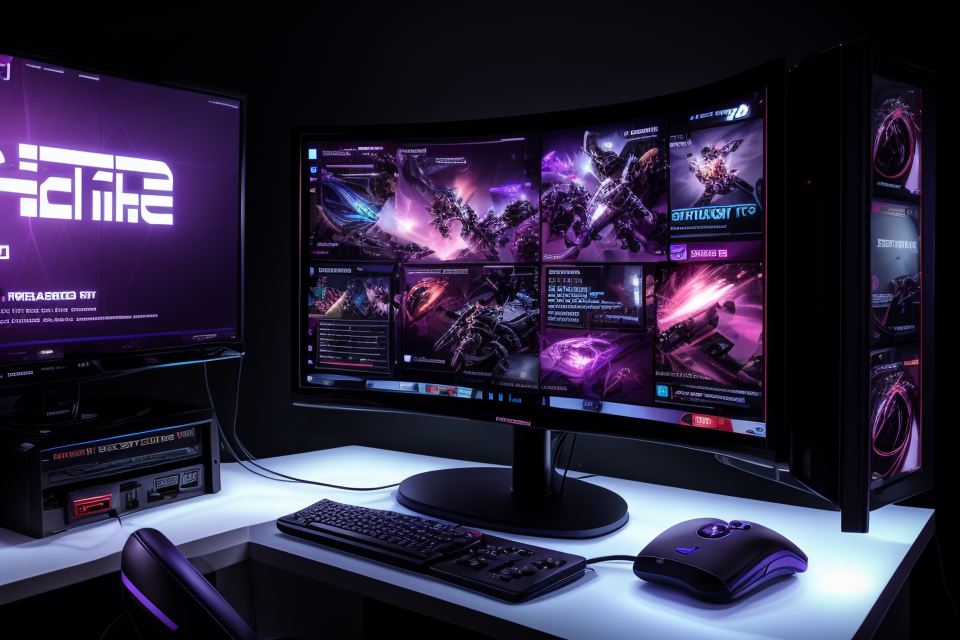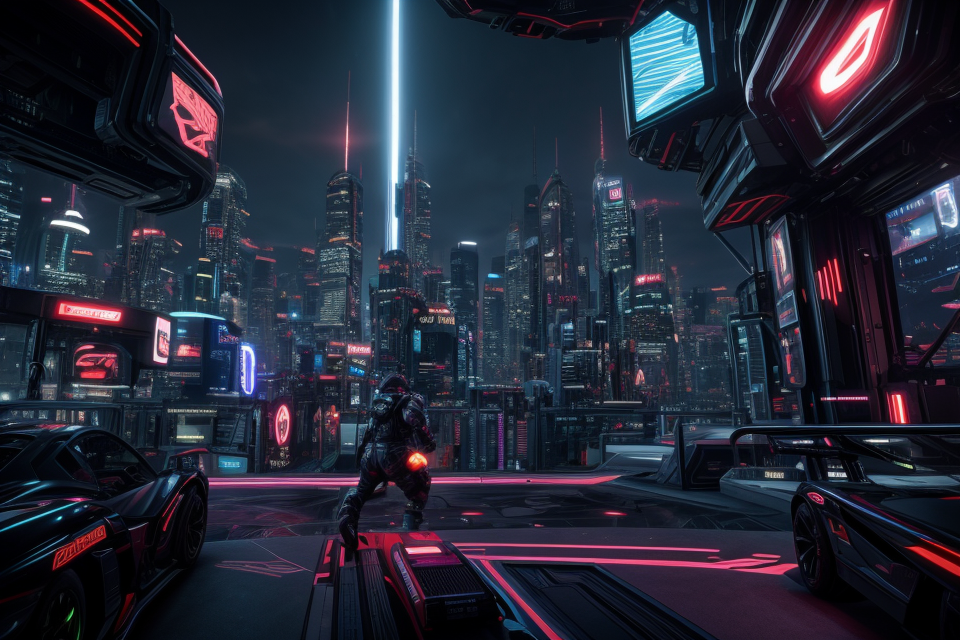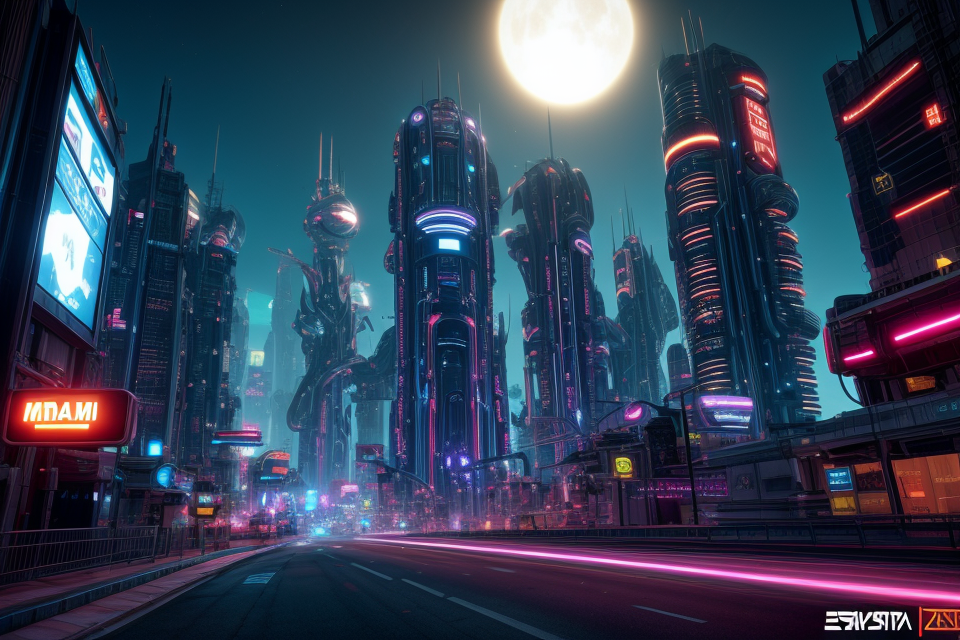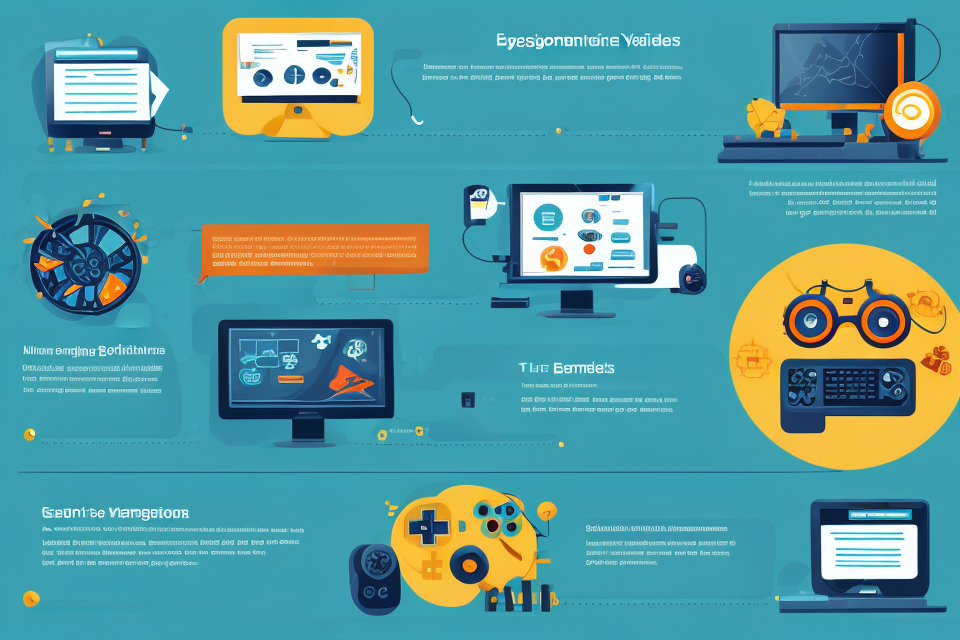
Are you tired of experiencing pixelated gameplay while streaming on Twitch? Do you want to know how to optimize your streaming experience? Look no further! In this article, we will dive into the world of Twitch screen resolution and how it can impact your gaming experience. We will explore what Twitch screen resolution is, how it works, and why it matters. Whether you’re a seasoned streamer or just starting out, this article will provide you with valuable insights to enhance your streaming game. So, buckle up and get ready to level up your Twitch game with us!
Twitch screen resolution refers to the size and quality of the video displayed on a Twitch stream. It can affect a viewer’s gaming experience by affecting the clarity and quality of the stream. A higher resolution will provide a clearer and sharper image, while a lower resolution may result in a pixelated and blurry image. A higher resolution also requires more bandwidth, so viewers with slower internet connections may experience buffering or other technical issues. Additionally, a higher resolution may require more powerful hardware, such as a high-end graphics card, which can be expensive and may not be necessary for all viewers. Overall, the Twitch screen resolution can have a significant impact on the viewer’s experience, and it is important to consider the trade-offs between image quality and technical requirements when choosing a resolution.
Understanding Twitch Screen Resolution
Definition of Twitch Screen Resolution
Twitch screen resolution refers to the visual quality of the stream that is being displayed on a viewer’s screen. It is determined by several factors, including the resolution of the streamer’s camera, the quality of the stream, and the viewer’s internet connection. The higher the resolution, the clearer and more detailed the image will be. This can have a significant impact on the overall gaming experience for both the streamer and the viewer.
Factors Affecting Twitch Screen Resolution
When it comes to Twitch screen resolution, there are several factors that can affect the gaming experience. These factors include:
- Display size: The larger the display size, the better the resolution. However, a larger display size also means that the screen may be further away from the user, which can cause distortion and affect the overall gaming experience.
- Display type: Different types of displays have different resolutions. For example, a 4K display will have a higher resolution than a 1080p display. The type of display used can significantly impact the gaming experience, especially when it comes to graphically intensive games.
- Refresh rate: The refresh rate of a display refers to how many times per second the display can refresh its image. A higher refresh rate can result in smoother motion and a more responsive gaming experience. However, a high refresh rate can also require more processing power, which can affect the overall performance of the game.
- Display calibration: If the display is not properly calibrated, it can affect the gaming experience. For example, if the colors are not accurate or the brightness is too high or too low, it can make it difficult to see the game clearly and negatively impact the overall gaming experience.
- Personal preferences: Each user has their own personal preferences when it comes to gaming. Some users may prefer a higher resolution, while others may prefer a larger display size. Ultimately, the most important factor is what works best for the individual user and their specific gaming needs.
How to Check Your Twitch Screen Resolution
To check your Twitch screen resolution, follow these steps:
- Open the Twitch website and log in to your account.
- Click on the “Settings” icon in the top right corner of the page.
- In the settings menu, click on the “Display” option.
- Your current screen resolution will be displayed in the “Screen Resolution” section.
Alternatively, you can also check your screen resolution by right-clicking on the desktop and selecting “Display settings” from the context menu. This will open the display settings window, where you can see your current screen resolution under the “Resolution” tab.
It’s important to note that your Twitch screen resolution affects the quality of the stream you are watching. A higher resolution will provide a clearer and sharper image, while a lower resolution may result in a blurry and pixelated image. Therefore, it’s recommended to have a high screen resolution to enhance your gaming experience on Twitch.
Impact of Twitch Screen Resolution on Gaming Experience
Effects on Visual Quality
Twitch screen resolution plays a significant role in determining the visual quality of your gaming experience. It is the number of pixels on a screen that make up the display, and the higher the resolution, the better the picture quality. In this section, we will explore the effects of Twitch screen resolution on the visual quality of your gaming experience.
- Definition of Visual Quality
Visual quality refers to the clarity and sharpness of the images displayed on a screen. It is determined by the number of pixels on the screen and the quality of the graphics card. A higher resolution means that there are more pixels on the screen, resulting in sharper and clearer images.
- Impact of Higher Resolution on Visual Quality
When a game is played on a screen with a higher resolution, the images displayed are sharper and clearer. This is because the higher resolution means that there are more pixels on the screen, which translates to more details in the images. Additionally, a higher resolution allows for more colors to be displayed on the screen, resulting in a more vibrant and realistic visual experience.
- Effects of Lower Resolution on Visual Quality
On the other hand, when a game is played on a screen with a lower resolution, the images displayed may appear pixelated and blurry. This is because there are fewer pixels on the screen, resulting in less detail in the images. Additionally, a lower resolution may result in a limited color palette, resulting in a less vibrant and realistic visual experience.
- Comparison of Visual Quality Across Different Resolutions
When comparing the visual quality of games played on screens with different resolutions, it is clear that the higher the resolution, the better the visual quality. For example, a game played on a screen with a resolution of 1080p will have better visual quality than the same game played on a screen with a resolution of 720p.
- Factors Affecting Visual Quality Besides Resolution
While resolution is a crucial factor in determining visual quality, it is not the only factor. Other factors such as the quality of the graphics card, the size of the screen, and the refresh rate of the screen can also impact the visual quality of a game.
In conclusion, Twitch screen resolution has a significant impact on the visual quality of your gaming experience. A higher resolution means sharper and clearer images, while a lower resolution may result in pixelated and blurry images. Therefore, it is essential to consider the resolution of your screen when gaming to ensure the best possible visual quality.
Effects on Gameplay
The resolution of a Twitch stream can have a significant impact on the gameplay experience for viewers. A higher resolution means that the stream will appear sharper and more detailed, which can lead to a more immersive experience. This is especially important for fast-paced games where quick reflexes and accurate aiming are essential.
In addition to enhancing the visual experience, a higher resolution can also make it easier for viewers to see important details such as enemy movements, power-ups, and other important game elements. This can give players an advantage in the game and help them to perform better.
However, it’s important to note that a higher resolution can also lead to increased latency, as the stream needs to be transmitted at a higher bandwidth. This can cause delays in the video feed, which can negatively impact the overall gaming experience.
Furthermore, the resolution of a Twitch stream can also affect the performance of the game itself. Some games may not be optimized to run at higher resolutions, which can lead to lag, stuttering, and other performance issues. This can be especially problematic for players who are competing in online multiplayer matches, as even a small amount of lag can be enough to give an opponent an advantage.
Overall, the resolution of a Twitch stream can have a significant impact on the gameplay experience for viewers. While a higher resolution can enhance the visual experience and provide an advantage in the game, it can also lead to increased latency and performance issues. It’s important for players to find a balance that works for them and their specific gaming setup.
Differences in Experience Across Devices
Twitch screen resolution refers to the pixel dimensions of the video stream displayed on a user’s device. The resolution of the stream can vary depending on the device being used, and it can significantly impact the overall gaming experience. In this section, we will explore the differences in experience across devices based on Twitch screen resolution.
Differences in Experience Across Devices
- Mobile Devices: Mobile devices such as smartphones and tablets typically have lower screen resolutions compared to desktop computers and gaming consoles. This means that the video stream on these devices may appear pixelated and may not be as sharp as on higher resolution devices. However, the smaller screen size can make the stream more immersive and provide a more personal viewing experience.
- Desktop Computers: Desktop computers typically have higher screen resolutions compared to mobile devices, which can result in a sharper and more detailed video stream. However, the larger screen size can make the stream less immersive and may require users to sit further away from the screen to get a comfortable viewing experience.
- Gaming Consoles: Gaming consoles such as PlayStation and Xbox typically have high screen resolutions, which can provide a sharp and detailed video stream. However, the screen size may be limited compared to desktop computers, which can affect the overall viewing experience.
In conclusion, the Twitch screen resolution can have a significant impact on the gaming experience across different devices. While lower resolutions may make the stream less immersive, they can also provide a more personal viewing experience. On the other hand, higher resolutions can provide a sharper and more detailed video stream, but they may require users to sit further away from the screen or may be limited by the screen size of gaming consoles.
Tips for Optimizing Twitch Screen Resolution
Adjusting Your In-Game Settings
Twitch screen resolution plays a significant role in the quality of your gaming experience. Adjusting your in-game settings can help you optimize your Twitch screen resolution for the best possible gaming experience. Here are some tips for adjusting your in-game settings:
- Resolution: The first step in adjusting your in-game settings is to select the appropriate resolution for your Twitch stream. Most games have an option to adjust the resolution, which allows you to customize the size of the game window. You can select a resolution that matches your Twitch stream settings, which ensures that your stream will look good for your viewers.
- Windowed Mode: Some games have an option to run in windowed mode, which allows you to play the game in a smaller window rather than full-screen mode. This can be helpful if you want to keep an eye on your Twitch stream while you play. To enable windowed mode, you’ll need to find the game’s settings and look for an option labeled “windowed mode” or “borderless window.”
- Display Settings: Most games have a variety of display settings that you can adjust to customize your gaming experience. These settings can include things like brightness, contrast, saturation, and sharpness. Adjusting these settings can help you optimize your Twitch stream for the best possible quality.
- Frame Rate: Frame rate refers to the number of frames that are displayed per second in a game. A higher frame rate can provide a smoother, more stable gaming experience. If you’re streaming on Twitch, you’ll want to make sure that your frame rate is high enough to provide a smooth experience for your viewers. You can adjust the frame rate settings in most games to achieve the desired frame rate.
- Graphics Quality: Graphics quality refers to the level of detail and complexity in a game’s graphics. Higher graphics quality can provide a more immersive gaming experience, but it can also require more processing power and can impact frame rate. You’ll need to find a balance between graphics quality and frame rate to optimize your Twitch stream.
By adjusting your in-game settings, you can optimize your Twitch screen resolution for the best possible gaming experience. Experiment with different settings to find the optimal configuration for your specific setup.
Choosing the Right Display Settings
Selecting the right display settings is crucial to achieving the best gaming experience on Twitch. To optimize your Twitch screen resolution, follow these steps:
- Determine your preferred aspect ratio:
- 16:9: This is the most common aspect ratio for monitors and TVs, providing a balanced viewing experience for most gamers.
- 21:9: This aspect ratio offers a more immersive gaming experience, ideal for wide-screen monitors or TVs.
- Set the resolution according to your display:
- Monitor: Choose a resolution that matches your monitor’s native resolution. For example, if you have a 1080p monitor, set the resolution to 1920×1080.
- TV: Select a resolution that matches your TV’s native resolution or the nearest supported resolution. For a 4K TV, this would be 3840×2160 (2160p).
- Adjust the display settings:
- Refresh rate: Choose the highest refresh rate your display supports, typically 60Hz, 120Hz, or 144Hz, for smoother gameplay and reduced motion blur.
- Response time: Select the fastest response time available, usually between 1ms and 5ms, to minimize ghosting and reduce input lag.
- Picture mode: Use a mode optimized for gaming, such as “Game” or “PC,” which generally disables any unnecessary post-processing effects that may affect performance.
- HDR (if supported): Enable HDR (High Dynamic Range) if your display supports it for enhanced color accuracy and contrast.
- Calibrate your display:
- Use a colorimeter or spectrophotometer to calibrate your display, ensuring accurate color representation and optimal gaming experience.
- Consider your gaming habits:
- If you frequently play games that require fast-paced movements, a high refresh rate and low response time are essential.
- If you enjoy games with vivid visuals and immersive environments, a display with a wide color gamut and high dynamic range may be more suitable.
By choosing the right display settings, you can customize your Twitch gaming experience to suit your preferences and enhance your overall performance.
Managing Graphics Quality and Performance
In order to achieve the best possible gaming experience on Twitch, it is important to optimize your screen resolution and graphics settings. One key aspect of this is managing your graphics quality and performance settings.
To begin with, it is important to understand the difference between these two settings. Graphics quality refers to the visual fidelity of the game, including factors such as texture quality, anti-aliasing, and post-processing effects. Graphics performance, on the other hand, refers to the smoothness and stability of the game, including factors such as frame rate, latency, and input lag.
In general, it is recommended to prioritize graphics performance over graphics quality when streaming on Twitch. This is because a stable and smooth stream is more important than a visually stunning one. However, it is still important to ensure that your graphics quality settings are set to a reasonable level in order to avoid any significant visual glitches or artifacts.
There are a few key steps you can take to manage your graphics quality and performance settings:
- Use Twitch’s built-in graphics settings: Twitch offers a range of graphics settings that you can use to optimize your stream for performance and quality. These include options such as auto-detect, which adjusts your settings based on your hardware and internet connection, and optimized presets, which provide a balance between performance and quality.
- Adjust your graphics quality settings: If you find that your stream is struggling to maintain a high frame rate or is experiencing input lag, you may need to adjust your graphics quality settings. This can include reducing texture quality, disabling anti-aliasing, or turning off post-processing effects.
- Use a graphics performance monitor: A graphics performance monitor, such as FRAPS or MSI Afterburner, can help you to monitor your frame rate and other performance metrics in real-time. This can help you to identify any bottlenecks in your system and make adjustments as needed.
- Test your stream: Before going live, it is important to test your stream to ensure that everything is working as it should be. This includes checking your graphics quality and performance settings, as well as testing your audio and video quality.
By following these tips, you can ensure that your Twitch stream looks and performs its best, providing your viewers with an enjoyable and immersive gaming experience.
Recap of Key Points
- Adjusting the screen resolution to match the game’s native resolution can lead to better visuals and performance.
- The aspect ratio of the Twitch stream should match the game’s aspect ratio for optimal viewing.
- It’s important to test different resolutions to find the sweet spot for your setup.
- Consider the resolution of the console or PC being used to stream, as well as the resolution of the capture card.
- Using a high-quality capture card can help ensure that the streamed footage is not pixelated or low-resolution.
- Streaming at a higher resolution can result in better quality footage, but may also require more bandwidth and processing power.
- Monitoring the Twitch stream’s bitrate and adjusting it as needed can help maintain a good balance between video quality and streaming performance.
Final Thoughts on Twitch Screen Resolution and Gaming Experience
Twitch screen resolution plays a crucial role in enhancing the overall gaming experience. However, it is essential to strike a balance between screen resolution and the computer’s processing power.
Increasing the screen resolution can improve the visual quality of the game, making it more immersive and enjoyable. However, it can also lead to a decrease in the frame rate, which can negatively impact the gaming experience.
Therefore, it is recommended to choose a screen resolution that provides the best balance between visual quality and performance. This can vary depending on the specific game and computer hardware.
It is also important to consider the screen size and resolution when streaming on Twitch. A higher screen resolution can provide a better viewing experience for the audience, but it can also increase the bandwidth requirements and make the stream less accessible for viewers with slower internet connections.
Ultimately, the choice of screen resolution should be based on personal preferences and the specific gaming setup. By following the tips provided in this article, you can optimize your Twitch screen resolution and enhance your gaming experience.
FAQs
1. What is Twitch screen resolution?
Twitch screen resolution refers to the dimensions of the video stream displayed on a Twitch channel. The most common resolutions are 720p, 1080p, and 4k. The resolution affects the quality of the video stream and the amount of detail that can be seen on the screen.
2. How does Twitch screen resolution affect my gaming experience?
The Twitch screen resolution can affect your gaming experience by impacting the quality of the video stream. A higher resolution will provide a clearer and more detailed image, which can enhance your overall gaming experience. However, it also requires more bandwidth and processing power, which may impact the performance of your device.
3. What is the recommended Twitch screen resolution?
The recommended Twitch screen resolution depends on several factors, including the type of content being streamed, the capabilities of your device, and your internet connection. As a general rule, a resolution of 1080p is a good balance between quality and performance. However, if you have a high-end device and a fast internet connection, you may want to consider a higher resolution such as 4k.
4. Can I change the Twitch screen resolution?
Yes, you can change the Twitch screen resolution by adjusting the settings in your Twitch account. You can also adjust the resolution of the video stream in the settings of the device you are using to watch the stream. Keep in mind that changing the resolution may impact the performance of your device and your internet connection.
5. Is a higher Twitch screen resolution worth the extra cost?
Whether a higher Twitch screen resolution is worth the extra cost depends on several factors, including the type of content being streamed, the capabilities of your device, and your internet connection. If you have a high-end device and a fast internet connection, a higher resolution may provide a better viewing experience. However, if you have an older device or a slower internet connection, the difference in quality may not be noticeable.


